David1226
Registered
This is a LGB 21711 analogue U-Class locomotive bought second hand, many years ago, on eBay. I have now digitised it by installing a LGB 55027 decoder, again bought many years ago and set aside for this purpose. As bought this Austrian locomotive was finished in lined black livery.
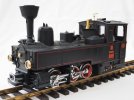
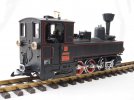
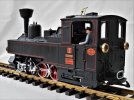
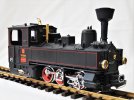
The U-Class locomotive has been produced by LGB for many years with countless versions, liveries and production modifications. This particular version is dated from 1988. It pre-dates digitalisation but does have four contact pins for track power and motor control, so fitting a decoder was relatively straightforward.
I carried out various modifications to the appearance of the locomotive. Every example of a U-Class that I have ever seen, has a shovel and a rake on the top of the cab roof. As this feature has been perpetuated from the earliest to the latest versions, I must assume that it is based on prototypical practice. I have never liked this feature as the tools appear to be just laying, unsecured, on a sloping roof, which strikes me as being a highly dubious practice. I could accept this if it were not for the fact that on every example, the mounting holes on the roof, for the shovel, are too close together, so that the handle of the shovel is bent into an ‘S’ shape. This is a defect that LGB have never sought to address over the years. This state of affairs is one that cannot be allowed to continue on the Claptowte Railway. The shovel and rake were removed from the cab roof and the resulting holes filled in. The tools were set aside to be re-used later.
With its origins very much at the beginning of LGB, another feature that has never been updated, is the semi-relief mouldings of the brake pipes on the front and rear of the locomotive. I set about remedying this for two reasons, first, all of the rolling stock, passenger and freight, on the Claptowte Railway, has the brake pipes fitted to the right of the centre buffer, on this model the semi-relief pipework is on the left, the wrong side. The other reason is the aesthetics of not having separately applied brake pipes. I carved off the semi-relief representations and sanded the bodywork smooth. On the rear buffer beam, I drilled two holes into which I could plug a spare LGB Toy Train brake pipe, salvaged from previous rolling stock conversions. On the front of the locomotive I extended the width of the buffer beam, using plasticard, to facilitate the placement of a brake pipe, again by drilling two holes into which it could be plugged.
I also carved/sanded down the raised data panel on the bottom of the rear right hand side of the cab. All of the other transfers were sanded off. I carved off the moulded representations of handrails on the upper cab sides, drilled holes and glued in brass wire handrails.
The loco comes with one crew figure. I attempted to remove this but rather than the base parting company with the footplate, his legs parted company with his feet, at the ankles. I teamed him up with a Driver Bob 3D printed G Scale figure from Clavey Models, via eBay, and introduced them both to the paintbrush.

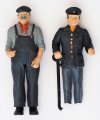
Having stripped down the model to its major component parts, I stripped out the cab of its fittings and glazing. I removed the funnel from the boiler. I then masked off the boiler so that I cold spray the tank tops and sides and the front end of the tanks/boiler. I then sprayed the tanks, cab, cab doors, and the newly extended front buffer beam, with grey plastic primer. When dry, the appropriate areas were sprayed with Halfords satin black. When this was dry, the cab interior was painted cream with the intention of Anglicising the appearance. Various control levers and wheels were picked out in red.
The wheels of this loco were originally red, common European practice. I repainted these black in order to tone down the European look. To further Anglicise the appearance, the buffer beams were painted red and the buffer heads had the white rim sanded off and were repainted black. I was not sure if the cab steps were metal or wood. I decided to paint the brown, to represent wood, in order to add a bit more interest.
When all of this was done, the loco was re-assembled. The LGB crew figure was reunited with his feet and he was joined in the cab by Driver Bob.
I fabricated and painted a pair of cradles from scrap brass strip and plasticard. These were fitted with brass wire pins, in the base, which were then glued into appropriately located holes drilled in the top of the right hand side tank. The moulded locating pins were cut off the tools, previously mounted on the cab roof, and, once painted, they were glued into place in the tank top cradles. I think this creates a bit more interesting detail than leaving them on the cab roof.
I realised, after the event, that I should have cut out and removed the moulded coal from the top of the coal bunker, as it is not the most realistic representation. Having already re-sprayed the area, I did not want to risk damaging the paintwork. I tried painting various pieces of the moulded coal in differing shades of black but the overall appearance was still rather flat. In the end I decided to just overfill the bunker by heaping up extra artificial coal on top of the bunker, to the extent that some of it spilled out onto the top of the water tank. This spillage was also glued in place for added interest..
The final update was to affix the etched brass name and number plates supplied by Light Railway Stores – Custom Nameplate Studio. It is the custom with the Claptowte Railway that all steam locomotives are named after female members of my family, in this case No2 is named ‘Kristin’ after my Daughter-in-Law.
The completed locomotive
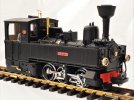
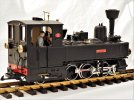
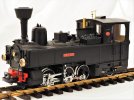
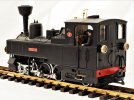
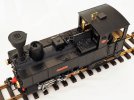
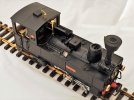

David




The U-Class locomotive has been produced by LGB for many years with countless versions, liveries and production modifications. This particular version is dated from 1988. It pre-dates digitalisation but does have four contact pins for track power and motor control, so fitting a decoder was relatively straightforward.
I carried out various modifications to the appearance of the locomotive. Every example of a U-Class that I have ever seen, has a shovel and a rake on the top of the cab roof. As this feature has been perpetuated from the earliest to the latest versions, I must assume that it is based on prototypical practice. I have never liked this feature as the tools appear to be just laying, unsecured, on a sloping roof, which strikes me as being a highly dubious practice. I could accept this if it were not for the fact that on every example, the mounting holes on the roof, for the shovel, are too close together, so that the handle of the shovel is bent into an ‘S’ shape. This is a defect that LGB have never sought to address over the years. This state of affairs is one that cannot be allowed to continue on the Claptowte Railway. The shovel and rake were removed from the cab roof and the resulting holes filled in. The tools were set aside to be re-used later.
With its origins very much at the beginning of LGB, another feature that has never been updated, is the semi-relief mouldings of the brake pipes on the front and rear of the locomotive. I set about remedying this for two reasons, first, all of the rolling stock, passenger and freight, on the Claptowte Railway, has the brake pipes fitted to the right of the centre buffer, on this model the semi-relief pipework is on the left, the wrong side. The other reason is the aesthetics of not having separately applied brake pipes. I carved off the semi-relief representations and sanded the bodywork smooth. On the rear buffer beam, I drilled two holes into which I could plug a spare LGB Toy Train brake pipe, salvaged from previous rolling stock conversions. On the front of the locomotive I extended the width of the buffer beam, using plasticard, to facilitate the placement of a brake pipe, again by drilling two holes into which it could be plugged.
I also carved/sanded down the raised data panel on the bottom of the rear right hand side of the cab. All of the other transfers were sanded off. I carved off the moulded representations of handrails on the upper cab sides, drilled holes and glued in brass wire handrails.
The loco comes with one crew figure. I attempted to remove this but rather than the base parting company with the footplate, his legs parted company with his feet, at the ankles. I teamed him up with a Driver Bob 3D printed G Scale figure from Clavey Models, via eBay, and introduced them both to the paintbrush.


Having stripped down the model to its major component parts, I stripped out the cab of its fittings and glazing. I removed the funnel from the boiler. I then masked off the boiler so that I cold spray the tank tops and sides and the front end of the tanks/boiler. I then sprayed the tanks, cab, cab doors, and the newly extended front buffer beam, with grey plastic primer. When dry, the appropriate areas were sprayed with Halfords satin black. When this was dry, the cab interior was painted cream with the intention of Anglicising the appearance. Various control levers and wheels were picked out in red.
The wheels of this loco were originally red, common European practice. I repainted these black in order to tone down the European look. To further Anglicise the appearance, the buffer beams were painted red and the buffer heads had the white rim sanded off and were repainted black. I was not sure if the cab steps were metal or wood. I decided to paint the brown, to represent wood, in order to add a bit more interest.
When all of this was done, the loco was re-assembled. The LGB crew figure was reunited with his feet and he was joined in the cab by Driver Bob.
I fabricated and painted a pair of cradles from scrap brass strip and plasticard. These were fitted with brass wire pins, in the base, which were then glued into appropriately located holes drilled in the top of the right hand side tank. The moulded locating pins were cut off the tools, previously mounted on the cab roof, and, once painted, they were glued into place in the tank top cradles. I think this creates a bit more interesting detail than leaving them on the cab roof.
I realised, after the event, that I should have cut out and removed the moulded coal from the top of the coal bunker, as it is not the most realistic representation. Having already re-sprayed the area, I did not want to risk damaging the paintwork. I tried painting various pieces of the moulded coal in differing shades of black but the overall appearance was still rather flat. In the end I decided to just overfill the bunker by heaping up extra artificial coal on top of the bunker, to the extent that some of it spilled out onto the top of the water tank. This spillage was also glued in place for added interest..
The final update was to affix the etched brass name and number plates supplied by Light Railway Stores – Custom Nameplate Studio. It is the custom with the Claptowte Railway that all steam locomotives are named after female members of my family, in this case No2 is named ‘Kristin’ after my Daughter-in-Law.
The completed locomotive







David



